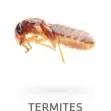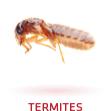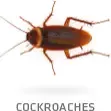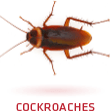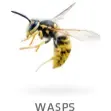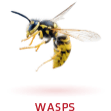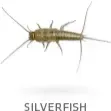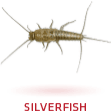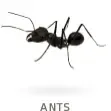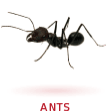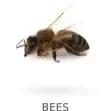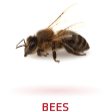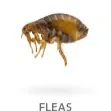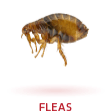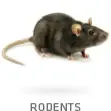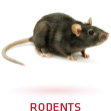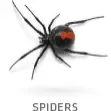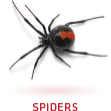Common Australian Pests
Garden Orb Web Spider
Large Garden Orb Web Spiders are moderately large, robust spiders and build sticky webs that cling tenaciously
to hands and face. The body is a plump triangular shape and hairy and the legs are as thick as match sticks. They are nocturnal spiders and sit centrally in the web usually strung between low trees and shrubs. During the day the spider moves to an elevated retreat and may be found huddled under eaves, leaves and occasionally in washing that has been left out overnight.
The colour and pattern of the Garden Orb Web Spiders are extremely variable, ranging from pale white to dark brown and with many patterns and spots, stripes and patches. The male has a slightly smaller body with many sharp spines on the legs. Although docile, this spider may produce mild pain, nausea, dizziness, numbness and swelling around the site of the bite.
Brush footed Trap door Spider
The Brush-footed Trap-door Spider is distinguished by its stocky body, long-like palps and two knee-like lobes to which the fangs join in the front. Most live in burrows with or without trap doors in the ground. The Brush-footed Trap-door Spiders have brushes or tufts of hair (claw tufts) on the ends of their legs.
Claw tufts enable small spiders to climb grass and other smooth surfaces. Most Brushfooted Trap-door Spiders, because of their large heavy bodies, can climb vertical surfaces at a slow, deliberate pace.
Brush-footed Trap-door Spiders range from small mottled brown spiders of 10-20 cent coin size to uniformly dark spiders larger than a 50 cent coin. The former are common in suburban gardens and may be dug up when gardening or flushed out by the heavy rain. The large Whistling Spiders are the largest Trap-door Spiders (their legs span about 12cm) and they make an audible hissing sound when disturbed. Their large, heavy body varies from dark-chocolate brown to pale fawn.
White tailed Spider.
The White-tailed Spider is found right across the Australian mainland, Tasmania and New Zealand. These spiders are cylindrical in shape, the male 12mm long, the female 17mm long. They have grey or black hairy bodies always with a white tip on the end with several paired white spots on the back. The legs are shiny and may span a 20 cent coin.
White-tailed Spiders can be found under stones and on the bark of trees. They frequently enter homes and can be found on the walls at night. They bite readily and frequently, causing discolouration, redness and blisters at the site of the bite, headaches, local burning, pain and itchiness.
Funnel Web Spider
Funnel-Web Spiders are potentially the most dangerous spider in the world and one of the most feared in Australia. The body length of the male is approximately 25mm in length and the female up to 40mm. They have a shiny dark brown to black head/thorax with a dark plum to black abdomen. Spinnerets project noticeably past the abdomen and the legs are moderately long. Both males and females of all species of Funnel-Webs are very aggressive and bites from either sexes are potentially dangerous, even fatal.
In Queensland, Funnel-Web Spiders tend to be more common in moist, cool rainforests, whereas in southern states they occur also in the drier eucalypt forest. Male Funnel-Web Spiders are often encountered in Summer when they wander in search of females which tend to remain in burrows until disturbed.
Wolf Spider
Wolf Spiders vary in size from a one cent coin to almost the width of an average adult hand. They are drab-coloured spiders with dark brown or black heads with lighter markings which may resemble a Union Jack pattern.
The body may have a dark bell-shaped mark and a series of fine black vee-shaped lines and whitish spots tapering to a vee towards the back. The legs are usually brown or grey and may have lighter rings around the middle section. From the front, two large and two smaller pairs of shiny black eyes are evident, and the two large fang-bearing bumps have a small, distinctive orange patch on the side.
Wolf Spiders are ground hunters often disturbed in gardens where they dig burrows in the soil or live among fallen leaves; some enter houses. If mishandled they may bite and cause rapid pulse, dizziness, nausea, swelling and persistent pain and tingling. However, most bites produce no reaction.
Huntsman Spider
Huntsman Spiders are reasonably easy to recognise due to their flattened bodies and the tendency for their legs to turn towards the front when stationary.
These spiders vary in size from medium to large (approx. 12.5 cm or 5 inch span). They are often referred to as the “Triantula or Large Crab Spider” due to their ability to move sideways as well as forward.
Huntsman Spiders are often found at night inside homes on walls and ceilings. In nature they hide by day under bark of trees and at night they hunt over tree trunks and on the ground. Although fast moving, they are timid spiders and will usually bite only if handled.
Some species are known to inflict a painful bite that may result in local discolouration and swelling, dizziness, vomiting, lethargy, irregular pulse, persistent nausea and sweating, local pain and in the form of a welt. In young children, the effects are probably more exaggerated.
Scorpions
Scorpions are easily recognised by having four pairs of legs, two lobster like claws used for grasping or seizing prey and a tail terminating in a stinger which is provided with poison glands. The large Brown Scorpions are common in gardens and forests throughout eastern Australia and are found under logs, rocks and in shallow burrows in earth banks. They are nocturnal but are often disturbed during the day. The sting is not known to be dangerous and the Scorpion tends usually to retreat than stand and fight.
Large Golden Scorpions include some of the biggest Scorpions of Queensland and are common on and west of the Great Dividing Range. Little is known of the habits and venom of those species, but no dangerous reactions to its sting have been recorded. Small Mottled Scorpions occur in moist forest areas along the east coast but are less common than the Large Brown Scorpion. The sting is not known to be dangerous.
Red Back Spiders
Typically, Redback Spiders are entirely black except for the broad band down the back of the body and a red hour-glass shaped mark underneath. However some females are fawn and the red markings are orange. Males may be white to brown with red markings and the young are pale dirtywhite, with six black spots down the back of the body and a paler hourglass mark underneath.
Large females may span a 50 cent coin. Males are smaller and not commonly seen.
Redback Spiders build their webs anywhere out of the direct effects of the weather. Webs occur on public buildings, parks, under steps, in corners, in grass and window sills and in crevices of bricks. Redback spiders are more common in Summer but occur in all seasons. Ideal conditions can produce several egglayings in a season.
The egg-sac of the Redback Spider is the shape and size of a pea and creamy white in colour. Redbacks are generally timid spiders except when an object is placed in their web or when tending young or eggs in the nest.
Only the female is large enough to effectively bite people. The bite is often felt but is apparently painless, although some victims have reported burning sensations. In most bites, intense local pain is experienced about five minutes after the bite. The main indication of a Redback Spider bite is localised sweating at the bite site. Other symptoms can include muscular weakness, lack of co-ordination, paralysis and tremors. Nausea, vomiting, local swelling, dizziness or fainting, palpitation, fever and muscular spasms have also been recorded.
Black House Spider

Black House Spiders are very black or very dark, hairy and have a indistinct faint pattern of lighter hairs on the body and legs. Webs are commonly found in the corners of windows, doors, eaves, under guttering and on brick walls. The web is very lacy and may appear funnel-shaped with one or more entrances. The bite may cause severe pain, numbness, headache, giddiness, nausea, vomiting, sweating and muscular pain. However, the spider is timid and retreats when approached. Bites are rare and occur usually when people attempt to move the webs.
St. Andrews Cross Spider
The St. Andrews Cross Spider forms an X of white silk in the centre of their orb web. Sometimes the X may be incomplete or absent altogether, but the characteristic X shape may be evident in the position of the spiders legs which are often held in pairs. These spiders are active both day and night and build their web in and near small shrubs and against walls.
The head is covered with silvery hairs and the body is marked with a series of transverse bands alternating silver and red or yellow with lighter spots. The legs are dark brown or black with one or two yellowish bands. The spider reaches an average leg span of about a 50 cent coin. It has not been known to bite.
Brown Widow Spider
The Brown Widow Spider is a member of the same group of spiders which contains the Redback. However, its toxin is approximately one-tenth the strength of the Redback. The Brown Widow is similar in shape to the Redback and may be slightly bigger. It has no stripe of any colour (red, orange or yellow) down the back. The body, head and legs vary in colour from fawn to black. In most specimens there are some lighter coloured markings along the side of the body.
Under the body, the hourglass mark characteristic of the Redback is yellow (not red). The egg sac is very unusual, about the shape and size of a pea, looking like a World War 2 marine mine. The major problem posed by this spider, apart from its painful bite, is its ability to produce up to 5000 young per season.
Brown House Spider
The Brown House Spider builds untidy tangled webs against walls, under eaves, around garage doors and among leaves on trees and shrubs.
The web may include a curled leaf as a retreat for the spider. In webs without the leaves, the spider sits among the tangle and when disturbed, drops and lies curled up and still until the apparent danger has past.
The body is distinctly mottled cream-brown. The legs are reddish brown and may span a 20 cent piece. The Brown House Spider has the same overall body shape as the Redback Spider but does not inflict a dangerous bite. Recorded symptoms include mild nausea and headache, pain and the formation of an itchy red welt at the bite site.
Mouse Spider
Mouse Spiders occur in all parts of Australia except Tasmania and are often considered as the true trap-door spiders. They live in vertical burrows in the soil which is lined with course silk and have two doors at the entrances. These doors may be thinsilken flaps or solid structures reinforced with soil.
Mouse Spiders are medium to large in size (25mm-35mm). Dark, often black spiders with short legs and a generally broad, squat appearence. The head and fang bearing appendages are raised and slopes steeply down towards the abdomen. in one species, this section is red in colour. The female and immature spiders remain hidden in the burrows and males are found wandering, sometimes over considerable distances. When dis-turbed, these spiders will assume the characteristic defence stance and if provoked they will plunge forward with their large fangs.
Several bites have been recorded without serious effects. Localised swelling with some pain, burning or itchiness at the site of the bite, has been reported.
Centipedes
Centipedes have a flattened, very flexible body with rather robust legs that extend from the sides of the body. Centipedes grow to a length of 15cm and live in logs, beneath damp and rotting wood, stones, spaces formed between rubbish and garden litter. They move rapidly and bite with two powerful jaws below the head.
The common garden Centipede is coloured dark green with amber coloured legs and their bite can cause severe pain which may last several days. No deaths have been recorded from bites of the centipedes within Australia.
Because of their length and many claws, Centipedes can easily climb a stick poked at them. Handling them in any way should be avoided.
Bed Bugs
While nothing has yet linked them to be a vector of disease, they do carry disease organisms such as hepatitis B and other pathogens. Their bites can cause skin irritation and allergic reactions. The stigma associated with thispest can cause loss of income both through bad reputation of an accommodation premises and also having rooms out of service during treatments. Adult bed bug are reddish brown in colour.They are approximately four to five millimetres long and have a flat, oval shaped body. Bedbugs can live on average for six to twelve months. Females lay one to five small eggs per day in cracks, crevices and on rough surfaces in their harbourages. Eggs usually hatch in six to seventeen days depending on temperature; but it can be much longer in cooler conditions.
Bed bugs only food source is blood of warm blooded animals. Humans are their preferred host but they can readily feed on poultry, rodents, birds, dogs and cats. They feed on their hosts using piercing and sucking mouthparts. They normally feed at night favouring darkness and dormant hosts, but can feed during daylight hours depending on food supply available. Bed bugs harbour in dark locations, remaining close by their food source. They hide in cracks and crevices including folds in mattress, ensembles, frames, bedheads, skirting boards, hollow curtain rods, light fittings etc. Bed bugs using aggregation pheromones tend to stay together. Where the infestation is quite large, a sweet sickly odour can be detected. Bedbugs cannot fly but are very mobile hitching a ride on luggage, clothing, bedding and furniture. Because of this trait and manoeuvrability they are an international pest.
References:
Doggett SL, Geary MJ. And Russell RC. 2004. The resurgence of bed bugs in Australia, with notes on their ecology and control. Environmental Health, 4: 30-38.
Doggett SL. 2005. Bed bug ecology and control. in Doggett (ed). 2005. Pests of Disease and Unease. Synopsis of Papers. Westmead Hospital. Westmead.
Service M.W. 2004 Medical and Veterinary Entomology for students (2nd Edition). Cambridge University Press London.
Stored Product Pests
Pests such as weevils, flour beetles and tropical warehouse moths are a major problem in many businesses. Damage is generally caused by the larval stage which can often be found in sealed packages, contaminating the product and rendering it unsaleable.
Fleas
Fleas prefer warm, humid conditions for survival. Fleas are found in and around pets bedding. Fleas survive on blood meal from the pets. The entire life cycle may take as little as 18 days to more than a year depending on the seasonal conditions. Fleas undergo a complete metamorphosis and there are four stages in the life cycle – Egg, Larva, Pupa, and Adult. Eggs are white and about 0.5mm in diameter.
Larva are small, active and have a worm like appearance. They are white or greyish in colour with 13 body segments. They are approximately 5mm in length. Adults. The adult female lays 4-8 eggs after a blood meal. In a lifetime she may lay up to several hundred eggs. Eggs can hatch within 2 days or up to several weeks depending on temperature and humidity. Eggs are laid on the host animal and usually drop off where pet animals frequent such as carpet areas, soil areas, or animal bedding.
References:
www.museum.vic.gov.au & www.garrards.com.au
Termites
Drywood, Dampwood and Subterranean Termites are located throughout many regions of Australia. They are a natural part of the environment. When pests such as subterranean termites attack ‘timber in service’ the damage they create can be severe.
Pest Status
Subterranean termites cause millions of dollars worth of damage to ‘timber in service’ and structures annually. These timber pests are an owner’s worst nightmare when they are first located or their damage detected. One in three houses throughout Australia are
affected by termites.
Ants
Ants cause problems in buildings when they are in search of food and water. They construct nests in buildings and gardens. Ants seek water in dry conditions. When they forage for food and water they send out large Ants construct nests in wall cavities, around the base of the buildings, pot plants, kitchens and bathrooms. In some cases ants nest in cavities which have decaying timbers. Seldom will ants attack solid structures. They will not cause any structural damage,
however they will use the decaying timber and excavate this timber out to nest in.
Ants can nest on the external areas of buildings and excavate soil up through paved areas. This can leave an unsightly appearence for the homeowner and can also cause subsidence of the pavers if the infestation is large. Some species of ants will occasionally attack electrical wiring, attracted to the insulation by the magnetic fields produced. When the ants attack the wires extensive damage could occur.
Generally ants are a nuisance to the homeowner rather than being a health problem.
References:
CSIRO Australia Ants Online. www.ento.csiro/science/ants
Cockroaches
Cockroaches are one of the world’s most revolting creatures. Hygiene conscious people are repulsed by their habits of regurgitating and defecating on foodstuffs, dishes and cutlery. Whether they are American, German or Australian cockroaches, disease and sickness is abi-product of their presence in man’s environment.
American Cockroaches

Large (35-40mm) reddish brown with a pale indistinct border around the pronotum. The wings completely cover the abdomen. They prefer damp areas, basements, drains, sewers and grease traps, but will also infect dry areas. This species can travel long distances for food. 15-20 nymphs per egg capsule hatch in 4-6 weeks.
German Cockroaches

Small (10-15mm) light brown with 2 darker stripes over their pronotum. Newly hatched nymphs are the size of a pinhead. The female is often observed carrying an egg capsule from which 30-40 nymphs hatch. A single female produces approximately 250 young and this can multiply to over 200,000 in 3 generations - they are often found in washrooms, food storage and preparation areas where warm, moist conditions exist.
Australian Cockroaches

Large - dark brown in colour with a pale stripe on each wing and a distinct shield on the pronotum. They infest mainly dry areas such as wall or ceiling voids etc. 15-20 nymphs hatch from each egg capsule.
Rodents
Rodents are of great concern in urban pest management in Australia. Of all the species of rodents in Australia, there are three species that cause major problems in our homes and commercial buildings. They are the Roof rat, Rattus rattus, The Norway rat Rattus norvegicus and the House mouse, Mus musculus.
Rodents are responsible for causing serious damage through gnawing, nibbling, and contaminating food products with their droppings and urine. Their numbers have been known to grow to plague proportions if left untreated in rural areas when conditions are right. They also cause serious damage to stock in commercial properties, resulting in significant financial loss.
Effects on Humans
There are five major effects on humans.
(1) Disease- Salmonella (food poisoning), Weil’s disease.
(2) Contamination- of human food by saliva, urine and faeces.
(3) Destruction- of packaged goods, stock and product loss.
(4) Physical Damage- Gnawing resulting in damage to property and fires.
(5) Fear and Apprehension- The stigma attached to the presence of rodents
The House Mouse is small, has rather large ears, a pointed snout and a tail that is as long as its body length and has hair that is fine, coloured brown to grey. They normally live for about 1 year and may have 6-10 litters per year with the average litter size of 5-6.They reach sexual maturity at about 6 weeks. The droppings are about 3-4 mm in length and pointed.
The Norway Rat has a thickset body, blunt snout, small close set ears and a tail shorter than its body length and fur that is coarse, red or brown in colour. They normally live for about 1 year, and have 5-6 litters per year with the average litter size of 8-10. They reach sexual maturity at 3-4 months. The droppings are about 18 mm in length and blunt on the ends.
The Roof Rat has a more pointed snout, large prominent ears and a tail longer than its body length and fur that is fine, coloured grey, black or brown and can be white underneath. They normally live for about a year and have about 4-5 litters per year with the average litter size of 6-8. They reach sexual maturity at 3-4 months. The droppings are about 12mm in length and pointed.
Acknowledgements & References:
Hadlington. P.1995. Urban Pest Control, UNSW, Sydney.
Mosquitoes
Are You Afraid to Go Out? Do mosquitoes and biting midges cramp your lifestyle? Mosquitoes and biting midges in general are prolific breeders. They abound in tropical and sub-tropical areas where conditions are perfect for their existence. Our outdoor lifestyle often brings us in contact with them, since we enjoy sharing the same type of habitat.
Pest Status
Apart from causing annoying itchy bites that can really limit outdoor activities, mosquitoes can also carry diseases and parasites that can affect you and your pets, including Ross River Virus, Dengue Fever, Malaria, Japanese Encephalitis and Heartworm (in dogs).
Ticks
Of all species of ticks in Australia, one dominates in terms of health effects. The Paralysis Tick, Ixodes holocyclus is a major pest of humans and animals alike. The Brown Dog Tick, Rhipicephalus sanguineus can also become a serious household pest where dogs inhabit.
Ticks are responsible for the poisoning of many native and domestic animals, the effects ranging from discomfort and illness to death. In humans, effects can range from mild to severe allergic reactions to paralysis. There have been recorded deaths attributed to the paralysis tick. Ticks also have the potential to spread infectious diseases, although Australia is largely free of tick borne diseases.
Ticks are related to the same group of animals as spiders. Their body shape is oval but alters once they are engorged. They have no eyes or antennae.
There are four stages in the life cycle – Egg, Larvae Nymph and Adult. The stages tend to be seasonal, with larvae more abundant in late summer/autumn, nymphs during late autumn/winter, and adults during spring/early summer. The complete life cycle takes about one year to complete.
Eggs. Adult females can lay up to 2500 eggs. Eggs are laid in clumps in moist situations, such as under bark and debris which may be in contact with the ground. Eggs will hatch in 40-60 days depending on temperature and humidity. Larvae hatch from the eggs, have six legs, and are approx 0.5-1mm in length. They require a blood meal after which they enlarge to around 1.5mm, drop off the host, and moult to become nymphs.
Nymphs have eight legs and are approximately 1-1.5mm in length. They require a blood meal, after which they enlarge to around 3.5mm, drop off the host, and moult to
become an adult.
References:
Doggett, S.L., 2005, The Ecology and Management of the Paralysis Tick,
Ixodes holocyclus, Pests of Disease and Unease
Flies
Flies are not just a nuisance; they carry diseases which pose serious health hazards to humans and animals. They cause economical losses to livestock and poultry production currently estimated in billions of dollars.
Non-biting flies feed on secretions from eyes and nostrils of animals which affects the feeding patterns of animals. Therefore a reduction is often noticed in growth and productivity of such animals.
Non-biting flies are not vectors of disease, however with the structure of their feet and mouthparts they can act as mechanical vectors for a range of viruses. There have been 65 diseases recorded which can transmit to humans such as typhoid fever, dysentery, cholera, poliomyelitis, yaws, anthrax, tularemia, leprosy to name a few.
References:
www.flycontrol.novartis


